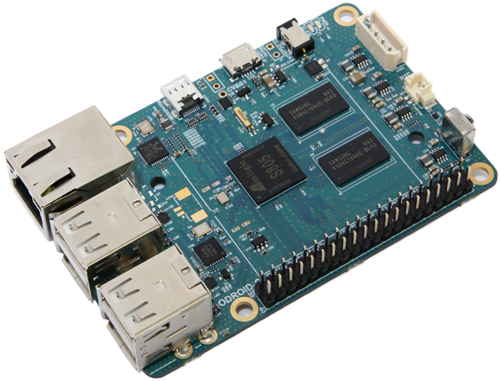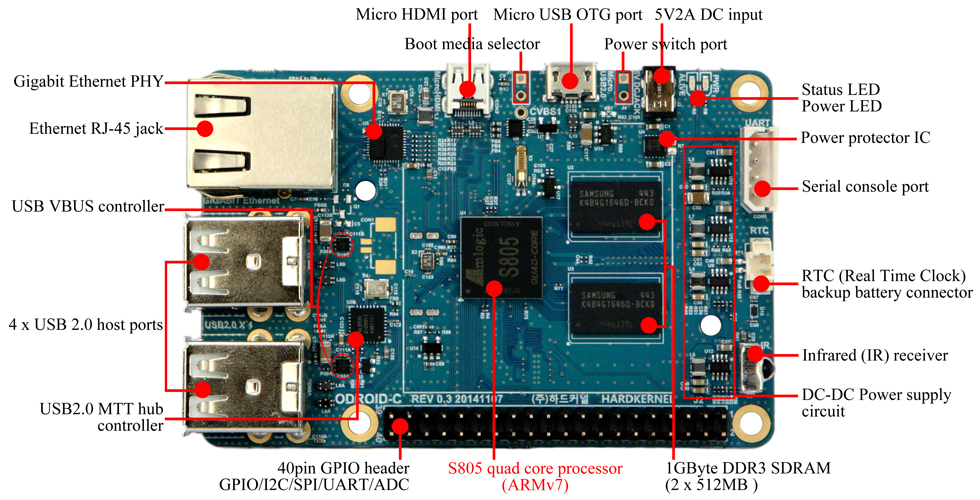ODROID-C1 - form from Raspberry Pi B +, 4 cores at 1500MHz, 1GB and price $ 35
Korean guys from Hardkernel have released their new microcomputer ODROID-C1, which is similar to the Raspberry Pi B + in the same form factor and with the same GPIO connector. At the same time, it has a quad-core Cortex-A5 processor with a frequency of 1.5 GHz, 1GB DDR3, a gigabit network card and other charms that significantly exceed the capabilities of the Malinka.

Even before this, Hardkernel released ODROID-W , which had the same Broadcom processor as the Malinka, was software compatible, and the main difference was the significantly smaller board sizes, especially in height. But the guys who bake raspberry pies did not like it and Broadcom banned Hardkernel from selling their processors. Only one batch of ODROID-W was released. It was announced in July, and in September a message appeared about the refusal of Broadcom.
')
Now, the Raspberry Pi B + has a serious competitor, and although the Korean version is less well known, it is well suited to those who, at a minimum, need more performance.

Offhand, in multi-threaded applications, if they fit in 512MB, ODROID-C1 will be about 10 times faster. There will be a more modern processor architecture and memory, and their approximately twice as high frequencies. It is incorrect to compare with those that do not fit in 512MB.
Chassis, memory cards, input / output port extenders (GPIO) and much more are available for the board. As you can see, the board from the Hardy is not only more productive, but it can do more out of the box. For example, an analog input port and an infrared receiver, which allows you to make a media extender from the board and use any remote control for this.
I want to note that the speed of eMMC memory cards lies in the region of 50MB / s, which often exceeds the microSD card approximately twice.
Fee specifications are fully open.

Ubuntu 14.04 and Android KitKat are supported, which means that, as usual with Odroid boards, a huge amount of software is available. I can share my experience. Walking on these our Internet sites from under Ubuntu 12 in Firefox, even from the ODROID-U2 board, which has Exynos4412 Prime 1.7Ghz ARM Cortex-A9, is uncomfortable in FullHD resolution. Although, perhaps, under Android it would be quite good, and I got used to powerful hospital facilities. The source codes of the Android and Linux builds are also open and will soon be uploaded to the network.
And a little video lastly
Link to ODROID-C1

A bit of background
Even before this, Hardkernel released ODROID-W , which had the same Broadcom processor as the Malinka, was software compatible, and the main difference was the significantly smaller board sizes, especially in height. But the guys who bake raspberry pies did not like it and Broadcom banned Hardkernel from selling their processors. Only one batch of ODROID-W was released. It was announced in July, and in September a message appeared about the refusal of Broadcom.
')
Now, the Raspberry Pi B + has a serious competitor, and although the Korean version is less well known, it is well suited to those who, at a minimum, need more performance.
Comparison of ODROID-C1 and Raspberry Pi B +

| ODROID-C1 | RPi Model-B + | |
| CPU | Amlogic S805 SoC4 x ARM® Cortex®-A5 1.5GHzARMv7 Architecture @ 28nm wafer | Broadcom BCM28351 x ARM11 700MHzARMv6 Architecture @ 40nm wafer |
| GPU | 2 x ARM® Mali ™ -450MP 600MHz | 1 x VideoCore IV 250MHz |
| Ram | 1GB 32bit DDR3 792MHz | 512MB 32bit LP-DDR2 400MHz |
| Flash storage | Micro-SD UHS-1 @ 100Mhz / SDR50 or eMMC storage option | Micro-SD @ 50Mhz / SDR25, No eMMC storage option |
| USB2.0 Host | 4 Ports | 4 Ports |
| USB2.0 Device / OTG | 1 Port for Linux USB Gadget driver | No |
| Ethernet / LAN | 10/100/1000 Mbit / s | 10/100 Mbit / s |
| Video output | HDMI | HDMI / Composite RCA |
| Audio output | HDMI | HDMI / 3.5mm Jack |
| Camera Input | USB 720p | MIPI CSI 1080p |
| Real time clock | YES (On-board RTC) | No (unless using an add-on module) |
| IR Receiver | YES (On-board IR Sensor) | No (unless using an add-on module) |
| IO Expansion | 40pin port (GPIO / UART / SPI / I2C / ADC) | 40pin port (GPIO / UART / SPI / I2C / I2S) |
| ADC | 10bit SAR 2 channels | No (unless using an add-on board) |
| Size | 85 x 56mm (3.35 ”x 2.2”) | 85 x 56mm (3.35 ”x 2.2”) |
| Weight | 40g (1.41 oz) | 42g (1.48 oz) |
| Price | $ 35 | $ 35 |
Offhand, in multi-threaded applications, if they fit in 512MB, ODROID-C1 will be about 10 times faster. There will be a more modern processor architecture and memory, and their approximately twice as high frequencies. It is incorrect to compare with those that do not fit in 512MB.
Chassis, memory cards, input / output port extenders (GPIO) and much more are available for the board. As you can see, the board from the Hardy is not only more productive, but it can do more out of the box. For example, an analog input port and an infrared receiver, which allows you to make a media extender from the board and use any remote control for this.
I want to note that the speed of eMMC memory cards lies in the region of 50MB / s, which often exceeds the microSD card approximately twice.
Fee specifications are fully open.

Soft
Ubuntu 14.04 and Android KitKat are supported, which means that, as usual with Odroid boards, a huge amount of software is available. I can share my experience. Walking on these our Internet sites from under Ubuntu 12 in Firefox, even from the ODROID-U2 board, which has Exynos4412 Prime 1.7Ghz ARM Cortex-A9, is uncomfortable in FullHD resolution. Although, perhaps, under Android it would be quite good, and I got used to powerful hospital facilities. The source codes of the Android and Linux builds are also open and will soon be uploaded to the network.
And a little video lastly
Link to ODROID-C1
Source: https://habr.com/ru/post/364343/
All Articles